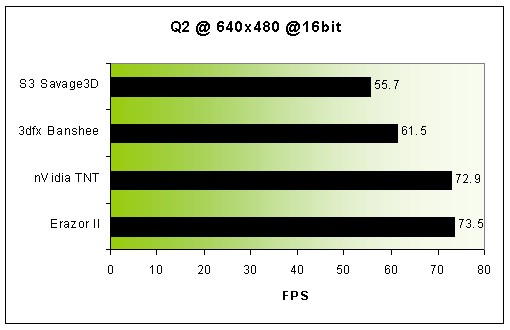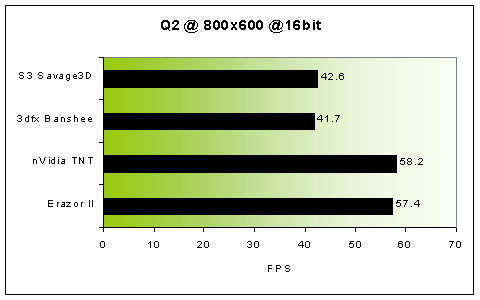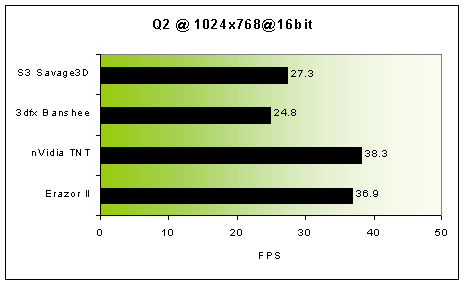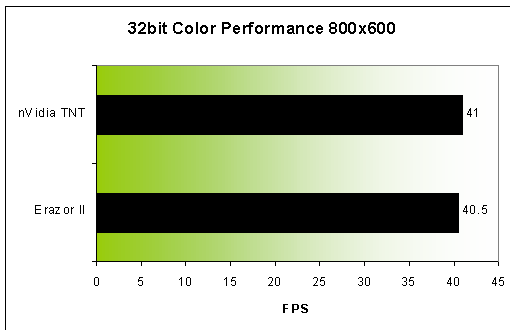All tests were conducted using Quake2 3.19, Creative board w/reference drivers for nVidia TNT results,
ELSA Erazor II 16MB RIVA TNT w/ELSA drivers
ELSA Victory II Banshee
AOpen PA70 Savage3D w/reference drivers
System: PII/400 + 64MB memory

The ELSA Erazor II board performed slightly faster than the reference board (Creative TNT) @ 640x480. Looking at these benchmarks though, there really isn't any performance reason to purchase the ELSA board over the competition (INCLUDING 3dfx Banshee + S3 Savage boards) because all the cards can sprint through this benchmark.

@800x600, the Erazor II board seems to yield a few decimals of an FPS to the reference TNT. Compared to the rest of the field, both the TNT boards begin to pull away, showing their superiority performance wise.

At 1024x768, there is no competition for the TNT boards. The other cards fall below the ideal playing fps (~30-35), making the TNT boards the only real choice for 1024x768 Quaking. The Erazor II board performs quite a bit slower than the reference board, even though it uses SGRAM. This proves that SGRAM is really negligible when it comes to performance, at least at the moment.

Even in 32bit color, which is very bandwidth intensive, the Erazor II board performs marginally slower than the reference TNT.
Performance Analysis
The Erazor II performs slower than the reference TNT used in this test. In reality; however, the difference is not noticeable. Whether or not that 1.5 extra frames per second is important to you is a different story, but as far as I am concerned, the performance of the creative board (reference) and the Erazor II is the same. The addition of SGRAM did not seem to make a difference in the performance of the ELSA board; however, as soon as more bandwidth intensive games are released, we may see a benefit for SGRAM. SGRAM also supposedly increases 2D performance at higher resolutions. Considering that most cards can blit the screen (even at 1600x1200x32) fast enough for anyone's eyes; 2D performance is not an issue anymore.
32bit color issues
I have heard many people express concerns regarding the 32bit performance of the TNT after seeing the stellar 32bit performance of the Rage 128. Since both of these cards render 32bits internally anyway (I believe), the only difference between outputting at 16bits of 32bits is bandwidth. The Rage 128 reduces Z-buffer depth to 16bits when rendering 32bit color; while the TNT does exactly the opposite, raise the Z-buffer from 16bits (as it is in Quake2, I believe it can be configured for 24bits @ 16bit color) to 24bits. Doing the math, the bandwidth requirements per pixel with the TNT is 32+24 = 56bits, while the Rage 128 does an entire 32bit pixel using 48bits of bandwidth. This is a major reason why the Rage 128 is faster than the TNT at 32bit color.
Back to ELSA Erazor II ...Conclusion
The Erazor II is a better board than most; however, when compared to other TNT boards, it failed to impress. While the marginally slower performance of the ELSA board wasn't a major issue in my disappointment, the price is. The board does feature an excellent manual, SGRAM, and a fan; however, the lowest street price I could find (~$130) does not justify this cards advantages over competing TNT boards, which are priced under $130, some around $110.
Performance 90% The Erazor II performance is incredible, allowing for Q2 @ 1024x768 to be a reality. Unfortunately, other TNT boards are faster.
Drivers 90% The Erazor II comes with an adequate set of drivers, based on a strong nVidia reference driver backbone. OpenGL is complete and stable; all the usual options are included. I would have liked to see an overclocking utility though...
Installation/Manual 95% Nothing went wrong, and the manual documented everything very well, plus it provided quality explanation of 3D jargon.
Quality 90% The Quality of the ELSA board is very good. The board contains SGRAM; which isn't really a performance increase, but it does show that ELSA believes in equipping their products with the best. I would have liked to see better cooling, even though the Erazor II has a fan, it doesn't seem to cool much better than a standard heatsink.
Price 75% There are cheaper TNT boards out there.
Value 80% If you want a quality TNT board and are willing to sacrifice a few extra dollars and give up 1 fps or so, the Erazor II is an excellent deal; the question is: Why give up a few extra dollars and 1 fps?
My Overall Impression 86% The ELSA Erazor II is based on an outstanding chipset, making it a great card without any effort applied. ELSA made a good attempt at making the Erazor II more than the average TNT board; however, their efforts didn't pay off in all areas.
How I Score
Performance - How fast the board is.s
Drivers - How stable and optimized the drivers are.
Installation/Manual - Where there any quirks during installation? How well is the manual documented?
Quality - How well does the board seem to be made? Did the manufacturer take any cost cutting short cuts? This score also reflects my impression of the card compared to others of the same chipset.
Game Bundle - Is the game bundle any good?
Price - How much does the board cost? Is it too expensive?
Value - How good is the price/performance ratio, taking into consideration other aspects such as quality, drivers, game bundle, APIs, etc.
My Overall Impression - How I personally feel about the board. Would I buy it? What if I didn't care about this or that.. etc.










0 Comments
View All Comments